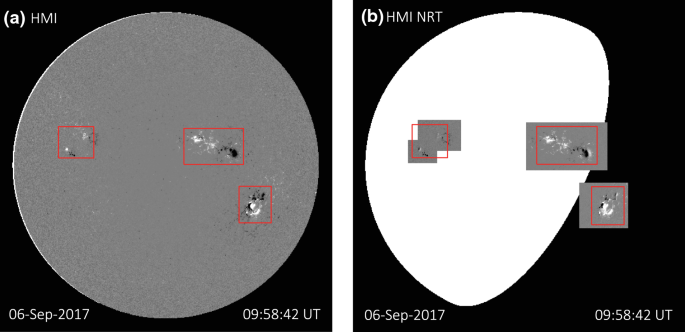Operational solar flare prediction model using Deep Flare Net


Website of operational DeFN showing a full-disk solar image and detected ARs, in addition to the full-disk forecasts, region-by-region forecasts, an alert mark, and a comment list (https://defn.nict.go.jp)
Abstract
We developed an operational solar flare prediction model using deep neural networks, named Deep Flare Net (DeFN). DeFN can issue probabilistic forecasts of solar flares in two categories, such as ≥ M-class and < M-class events or ≥ C-class and < C-class events, occurring in the next 24 h after observations and the maximum class of flares occurring in the next 24 h. DeFN is set to run every 6 h and has been operated since January 2019. The input database of solar observation images taken by the Solar Dynamic Observatory (SDO) is downloaded from the data archive operated by the Joint Science Operations Center (JSOC) of Stanford University. Active regions are automatically detected from magnetograms, and 79 features are extracted from each region nearly in real time using multiwavelength observation data. Flare labels are attached to the feature database, and then, the database is standardized and input into DeFN for prediction. DeFN was pretrained using the datasets obtained from 2010 to 2015. The model was evaluated with the skill score of the true skill statistics (TSS) and achieved predictions with TSS = 0.80 for ≥ M-class flares and TSS = 0.63 for ≥ C-class flares. For comparison, we evaluated the operationally forecast results from January 2019 to June 2020. We found that operational DeFN forecasts achieved TSS = 0.70 (0.84) for ≥ C-class flares with the probability threshold of 50 (40)%, although there were very few M-class flares during this period, and we should continue monitoring the results for a longer time. Here, we adopted a chronological split to divide the database into two for training and testing. The chronological split appears suitable for evaluating operational models. Furthermore, we proposed the use of time-series cross-validation. The procedure achieved TSS = 0.70 for ≥ M-class flares and 0.59 for ≥ C-class flares using the datasets obtained from 2010 to 2017. Finally, we discuss the standard evaluation methods for operational forecasting models, such as the preparation of observation, training, and testing datasets and the selection of verification metrics.
我们利用深度神经网络开发了一个可操作的太阳耀斑预测模型,命名为深耀斑网(deep flare Net, DeFN)。DeFN可以对观测后24小时内发生的≥m级和< m级事件或≥c级和< c级事件以及未来24小时内发生的最大级别两类太阳耀斑进行概率预报。DeFN每6小时运行一次,自2019年1月开始运行。太阳动力观测台(SDO)拍摄的太阳观测图像输入数据库是从斯坦福大学联合科学行动中心(JSOC)运营的数据存档中下载的。利用多波长观测数据,从磁图中自动检测出活动区域,并在每个区域中近乎实时地提取出79个特征。将火炬标签附加到特征数据库中,然后将数据库标准化并输入到DeFN中进行预测。DeFN使用2010年至2015年获得的数据集进行预训练。用真实技能统计(TSS)的技能得分对模型进行评估,得出≥m级耀斑的TSS = 0.80,≥c级耀斑的TSS = 0.63的预测结果。为了比较,我们对2019年1月至2020年6月的运营预测结果进行了评估。我们发现,对于≥c级耀斑,DeFN预报的TSS = 0.70(0.84),概率阈值为50(40)%,尽管在此期间m级耀斑很少,我们应该继续监测更长时间的结果。在这里,我们采用了按时间顺序划分的方法,将数据库分为训练和测试两个部分。按时间顺序划分似乎适合于评估操作模型。此外,我们建议使用时间序列交叉验证。使用2010 - 2017年获得的数据集,该程序获得≥m级耀斑的TSS = 0.70,≥c级耀斑的TSS = 0.59。最后,我们讨论了业务预测模型的标准评估方法,如观测、训练和测试数据集的准备,以及验证指标的选择。
Fig. 1
Flowchart of operational DeFN. It is executed using the NRT data and the pretrained model. The best-performing model among the models trained using the 2010–2015 datasets is chosen as the pretrained model
Fig. 2
Full solar disk vector magnetograms taken by HMI/SDO on 6 September 2017. a HMI definitive series data for the full disk and the areas detected by DeFN with red frames. b HMI NRT data showing the HARP areas in gray scale and the areas detected by DeFN. Note that both HARP and DeFN areas overlapped each other. If DeFN areas are outside the HARP areas, the data are set to zero


























 1235
1235

 被折叠的 条评论
为什么被折叠?
被折叠的 条评论
为什么被折叠?








